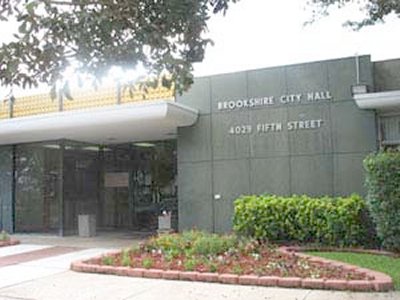|
The Community Of Brookshire
A Profile
The City of Brookshire was incorporated in 1946. Before that time it had all of the characteristics of a very small town and farming community. Brookshire has a long history of farming and ranching. Flat land, productive soil and good rainfall make the area ideal for crops which need a lot of water. Plentiful grass and open land are ideal for the cattle industry. Agriculture was the major reason in the beginning for the existence of Brookshire. Agriculture storage silos still operate here, but not at their peak as they did in the years of the past. Interstate 10 has changed the industry in Brookshire. Industries, like the Flying J Truck Stop, that need to be located on major transportation arteries (like the freeway or railway) have made Brookshire home. With the westward sprawl of Houston and the tremendous growth of our neighboring town, Katy, our city is set for much more growth. We are encouraging economic growth in a coordinated, enthusiastic and cooperative approach through civic and business leaders.
 The Waller County Museum
A History Of Brookshire, Texas
 The Brookshire Times 1897
There is no town in the State that can compare with this place in capacity of growth and quick ascendancy to a high standard, both financially and influentially. It is a source of wonder to the people in other portions of the State, how this town, built on the prairie, attained such magnitude and commercial importance in so short a time.
The MK&T Railway, in the early nineties, prepared to build into Houston. When the surveying corps selected the route between Sealy and Houston it passed through some of the finest land in the South, commonly called the "Brazos bottoms." The station of Brookshire was platted in what, to an inexperienced man, would be considered the opposite of an advantageous site for a city. But the officials planned even better than they knew. Though the location was on a prairie, it was only two to three miles from the bottoms, and this contiguity has given the little city the finest freight traffic for its size in the State.
The place was named in honor of Nathan Brookshire, who is a large land owner in the vicinity, and a leading resident. The city, itself, is situated on the William Cooper survey, one of the oldest head rights in the State. The country around is very fertile, the bottom land producing from one to two bales of cotton and over fifty bushels of corn to the acre; and the prairie from one-half to a bale of cotton to the acre. The prairie herbage is sweet and succulent nearly the year round, and furnishes splendid grazing for hundreds of head of cattle. Besides cotton and corn, truck farming is also an industry, as Houston always offers a remunerative market. Melon growing was also started last year. Enough melons were raised to ship ten car-loads. Fruits do well and peach and pear orchards and vineyards abound; some already bearing and others only in their incipiency, yet all have a healthy yielding appearance.
There are gins located in the heart of the city, the property of Houston parties. They are considered the equal of any in Texas, both in capacity and in construction. Fifty bales per day are easily turned out. They received a large amount of cotton grown in the vicinity, and with the output of surrounding gins, Brookshire shipped over 10,000 bales of cotton, which is more than many places of triple its size did. In addition to cotton, the Houston oil mills received 10 cars of cotton seed. This traffic, when computed in dollars and cents, indicates a good profit to both the Katy and the town.
The pecan crop in Waller County this year is something immense; a number of carloads have already been shipped from this point, and there are many bushels to gather. The average price paid by local buyers is 5 cents per pound.
Water is obtained at a depth of sixty feet and is of the freestone quality, for which Waller County is noted. Fuel is abundant, as the immense Brazos valley bottoms are only a couple of miles away.

No © Copyright. All material in this site may be used to educate everyone, Masons and non-Masons alike about Freemasonry and for the promotion of Freemasonry.
|
The Pine Island Webwright
Page Crafted By Corky

